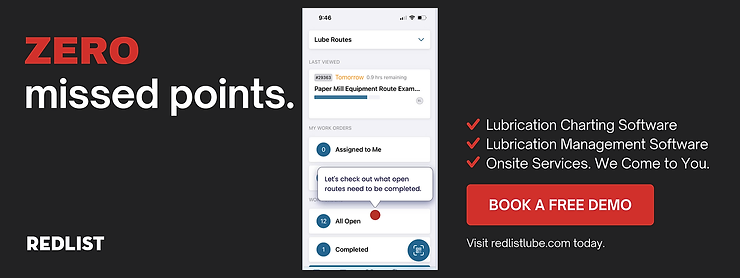Industrial Lubrication: Effective Solutions to Common Challenges
- Redlist

- Jul 22, 2024
- 4 min read
Updated: Aug 6, 2024

Industrial lubrication is an essential aspect of maintaining machinery and equipment. Ensuring that machine parts are properly and constantly lubricated helps in maintaining machine efficiency, longevity, and reliability. This seemingly simple task, however, comes with its own set of complex challenges.
This post explores the common challenges of industrial lubrication and provides effective solutions to address them.
Common challenges of industrial lubrication
Challenge 1: Lubricant Selection
There is a dauntingly large number of industrial lubricants on the market. This wide variety of choices comes from lubricants with different base oil types, additives, viscosity, and other properties.
Solution:
Assess Needs - Understand the specific needs of the machinery. The load, speed, operating conditions, etc. determine the ideal lubricant to be used.
Manufacturer’s Recommendations - Consult the OEM (original equipment manufacturer) recommendations for the lubricant types and specifications.
Consult with Suppliers - Lubricant suppliers can help select products that are tailored to your specific needs. Also, they can advise if you already ordered lubricant suited to this equipment, helping you avoid stocking multiple types or brands of the same lube.
Challenge 2: Controlling Contamination
Contamination happens when dirt, dust, metal particles, or moisture enter lubricants or lubrication systems. Contaminants degrade the chemicals in the lubricant, leading to decreased lubricating abilities and potential machinery damage. Contaminated or dirty lubricants also become rough and abrasive, increasing wear and breakdown of machine parts.
Solution:
Sealing Solutions - Implement using high-quality seals and coverings to prevent entry of contaminants.
Regular Filtration - Filter lubricants regularly using an effective filtration system to remove contaminants.
Routine Monitoring - Perform regular monitoring of lubricant health and condition using oil analysis to identify early signs of contamination.
Challenge 3: Lubricant Degradation
Lubricating abilities can also degrade due to long-term exposure to high temperatures, oxidation, etc. Degraded lubricants result in a high potential for wear and tear.
Solution:
High-Quality Lubricants - Purchase high-quality lubricants with high thermal stability and oxidation resistance, especially if your operating conditions involve high temperatures.
Proper Storage - Ensure proper storage conditions by keeping storage areas clean, dry, and protected from sunlight and other sources of contamination. Here are some simple strategies for maintaining your lubrication storage.
Regular Replacement - Set a schedule for the regular replacement of lubricants based on OEM recommendations and operational conditions.
Challenge 4: Incorrect Lubrication
Incorrect lubrication can occur through over-lubrication and under-lubrication. Both can cause significant damage to machines and equipment. Over-lubrication leads to overheating, leakage, and contamination, while under-lubrication leads to faster wear and tear due to increased friction.
Solution:
Automated Lubrication Systems - Automating lubrication lets you deliver precise amounts of lubricant at regular intervals.
Routine Inspections - Ensure adequate lubrication levels by regular inspections, and addressing discrepancies, if any.
Training & Awareness - Train maintenance technicians and staff on the importance of proper lubrication, the negative impacts of inadequate lubrication, and signs of lubrication issues they can watch for. Here are the primary reasons why employee training is vital.
Challenge 5: Lubricant Incompatibility
When incompatible lubricants are mixed, chemical reactions can occur. These reactions can lead to reduced lubrication performance and equipment damage.
Solution:
Standard Lubricants - If possible, use one type of lubricant as the standard for all machines to reduce the risk of incompatibility.
Labelling and Color-Coding - Clearly label and use color codes on all lubrication points and lubricant containers to avoid accidental mixing.
Compatibility Testing - If you must switch lubricants, ensure safe mixing or transitioning by conducting compatibility testing.
Challenge 6: Extreme Operating Conditions
Specialized lubrication strategies are often required for machinery that is subjected to extreme working conditions such as high temperatures, heavy loads, etc. These conditions pose a great challenge in finding suitable lubricants.
Solution:
Specialty Lubricants - Select lubricants specifically designed for your working conditions. Work with lubricant suppliers to develop customized lubricants tailor-fitted to these conditions.
Enhanced Monitoring - Increase the frequency of monitoring to detect issues early, adjusting schedules whenever necessary.
Additional Measures - Employ additional protective measures such as seals, coverings, or cooling or ventilating systems.
Challenge 7: Lubrication System
Some lubrication systems are poorly designed, delivering inconsistent lubrication. Thus, some areas may be over-lubricated while others may be under-lubricated.
Solution:
Customization - Work with lubrication system engineers to design and produce customized lubrication systems for your specific set-up and conditions.
Regular Audits - Regular audits help identify and rectify design flaws in the lubrication system.
System Upgrades - Consider investing in lubrication system upgrades to improve lubrication data collection, storage, and analysis.
Challenge 8: Lubrication Management
Lubrication management is a systematic approach to ensuring the proper implementation of various lubrication processes in all stages and areas. However, lubrication management involves complex and interrelated tasks such that managing them can be overwhelming, time-consuming, and prone to error.
Solution:
Planning & Implementation Strategies - Employ thorough planning and development of effective implementation strategies by considering updated and relevant asset information.
Continuous Improvement - Regularly evaluate current lubrication management processes and steps to identify areas for improvement.
Management Software - Use management software like a Lubrication Management System to track lubrication activities, collect data, and analyze them to streamline and improve lubrication processes.
Overcome Industrial Lubrication Challenges with Redlist
The solutions to your industrial lubrication challenges are within your reach with Redlist’s Lubrication Management Software. This state-of-the-art lubrication software comes with powerful functions and features to ensure correct lubricant selection, contamination control, timely maintenance, and continuous improvement through data-driven insights and technology integration.
Leveraging Redlist gives you a lubrication process that is up to par with the global standards of your industry. Take the best step towards sustained lubrication performance and asset longevity, and schedule your free demo with our lubrication experts today!






Comments